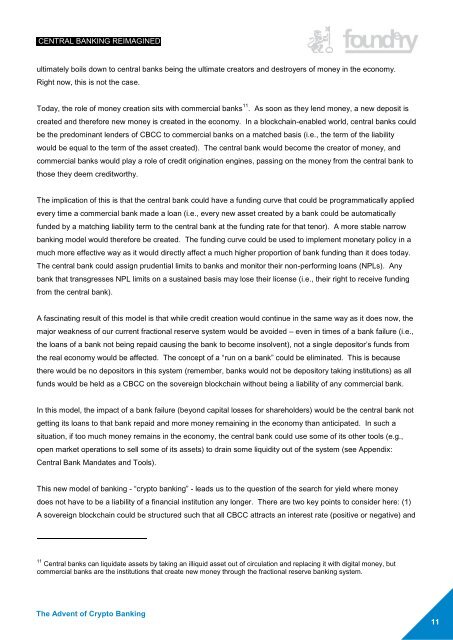The Advent of Crypto Banking
The_Advent_of_Crypto_Banking
The_Advent_of_Crypto_Banking
You also want an ePaper? Increase the reach of your titles
YUMPU automatically turns print PDFs into web optimized ePapers that Google loves.
CENTRAL BANKING REIMAGINED<br />
ultimately boils down to central banks being the ultimate creators and destroyers <strong>of</strong> money in the economy.<br />
Right now, this is not the case.<br />
Today, the role <strong>of</strong> money creation sits with commercial banks 11 . As soon as they lend money, a new deposit is<br />
created and therefore new money is created in the economy. In a blockchain-enabled world, central banks could<br />
be the predominant lenders <strong>of</strong> CBCC to commercial banks on a matched basis (i.e., the term <strong>of</strong> the liability<br />
would be equal to the term <strong>of</strong> the asset created). <strong>The</strong> central bank would become the creator <strong>of</strong> money, and<br />
commercial banks would play a role <strong>of</strong> credit origination engines, passing on the money from the central bank to<br />
those they deem creditworthy.<br />
<strong>The</strong> implication <strong>of</strong> this is that the central bank could have a funding curve that could be programmatically applied<br />
every time a commercial bank made a loan (i.e., every new asset created by a bank could be automatically<br />
funded by a matching liability term to the central bank at the funding rate for that tenor). A more stable narrow<br />
banking model would therefore be created. <strong>The</strong> funding curve could be used to implement monetary policy in a<br />
much more effective way as it would directly affect a much higher proportion <strong>of</strong> bank funding than it does today.<br />
<strong>The</strong> central bank could assign prudential limits to banks and monitor their non-performing loans (NPLs). Any<br />
bank that transgresses NPL limits on a sustained basis may lose their license (i.e., their right to receive funding<br />
from the central bank).<br />
A fascinating result <strong>of</strong> this model is that while credit creation would continue in the same way as it does now, the<br />
major weakness <strong>of</strong> our current fractional reserve system would be avoided – even in times <strong>of</strong> a bank failure (i.e.,<br />
the loans <strong>of</strong> a bank not being repaid causing the bank to become insolvent), not a single depositor’s funds from<br />
the real economy would be affected. <strong>The</strong> concept <strong>of</strong> a “run on a bank” could be eliminated. This is because<br />
there would be no depositors in this system (remember, banks would not be depository taking institutions) as all<br />
funds would be held as a CBCC on the sovereign blockchain without being a liability <strong>of</strong> any commercial bank.<br />
In this model, the impact <strong>of</strong> a bank failure (beyond capital losses for shareholders) would be the central bank not<br />
getting its loans to that bank repaid and more money remaining in the economy than anticipated. In such a<br />
situation, if too much money remains in the economy, the central bank could use some <strong>of</strong> its other tools (e.g.,<br />
open market operations to sell some <strong>of</strong> its assets) to drain some liquidity out <strong>of</strong> the system (see Appendix:<br />
Central Bank Mandates and Tools).<br />
This new model <strong>of</strong> banking - “crypto banking” - leads us to the question <strong>of</strong> the search for yield where money<br />
does not have to be a liability <strong>of</strong> a financial institution any longer. <strong>The</strong>re are two key points to consider here: (1)<br />
A sovereign blockchain could be structured such that all CBCC attracts an interest rate (positive or negative) and<br />
11 Central banks can liquidate assets by taking an illiquid asset out <strong>of</strong> circulation and replacing it with digital money, but<br />
commercial banks are the institutions that create new money through the fractional reserve banking system.<br />
<strong>The</strong> <strong>Advent</strong> <strong>of</strong> <strong>Crypto</strong> <strong>Banking</strong><br />
11


